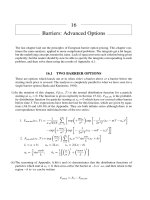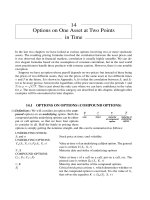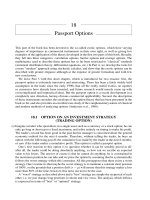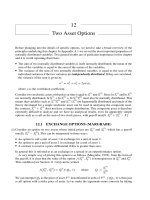Two Asset Options
Bạn đang xem bản rút gọn của tài liệu. Xem và tải ngay bản đầy đủ của tài liệu tại đây (328.55 KB, 16 trang )
12
Two Asset Options
Before plunging into the details of specific options, we need to take a broad overview of the
principles underlying this chapter. In Appendix A.1 we set out the most important properties of
normally distributed variables. Two general results are of particular importance in this chapter
and it is worth repeating them here:
r
The sum of two normally distributed variables is itself normally distributed; the mean of the
sum of the variables is equal to the sum of the means of the variables.
r
The variance of the sum of two normally distributed variables is equal to the sum of the
individual variances if the two variances are independently distributed. If they are correlated,
the variance of the sum is given by
σ
2
= σ
2
1
+ σ
2
2
+ 2ρσ
1
σ
2
where ρ is the correlation coefficient.
Consider two stochastic assets with prices at time t equal to S
(1)
t
and S
(2)
t
. Since ln S
(1)
t
and ln S
(2)
t
are normally distributed, ln S
(1)
t
+ ln S
(2)
t
= ln S
(1)
t
S
(2)
t
must also be normally distributed. This
means that variables such as S
(1)
t
S
(2)
t
and S
(1)
t
/S
(2)
t
are lognormally distributed and much of the
theory developed for a single stochastic asset can be used in analyzing the composite asset.
By contrast, S
(1)
t
+ S
(2)
t
does not have a simple distribution. This composite asset is therefore
extremely difficult to analyze and we have no analytical results, even for apparently simple
options such as a call on the sum of two stock prices, with payoff max[0, S
(1)
T
+ S
(2)
T
− X ].
12.1 EXCHANGE OPTIONS (MARGRABE)
(i) Consider an option on two assets whose initial prices are S
(1)
0
and S
(2)
0
, which has a payoff
max[0, S
(1)
T
− S
(2)
T
]. This can be interpreted in three ways:
r
An option to call a unit of asset 1 in exchange for a unit of asset 2.
r
An option to put a unit of asset 2 in exchange for a unit of asset 1.
r
A contract to receive a price differential if this is greater than zero.
In general this is referred to as an exchange or a spread or an outperformance option.
A very simple way of pricing this option is as follows (Margrabe, 1978): from the form of
the payoff, it is clear that the value of the option f (S
(1)
0
, S
(2)
0
) is homogeneous in S
(1)
0
and S
(2)
0
.
This condition [see Section 11.1(ii)] can be written
f
S
(1)
0
, S
(2)
0
= S
(2)
0
f (Q
0
, 1) where Q
t
=
S
(1)
t
S
(2)
t
We can interpret Q
0
as the price of asset S
(1)
denominated in units of S
(2)
. f (Q
0
, 1) is then just
a call option with a strike price of unity. Let us make the arguments more concrete by taking
12 Two Asset Options
a specific example where S
(1)
0
is today’s $ price of a barrel of oil and S
(2)
0
is today’s $ price of
an ounce of gold. The quantity Q
0
is then today’s oil price expressed as ounces of gold per
barrel. f (Q
0
, 1) is the value (expressed in ounces of gold) of a call option to buy a barrel of
oil for 1 ounce of gold (probably not worth a lot at present rates!). In order to price this option
we need to first make a short detour and re-examine some fundamental principles.
(ii) Two concepts underlie the notion of risk neutrality: first, which everybody focuses on, is the
no-arbitrage principle. The second is so self-evident that it is easy to overlook: if we borrow or
deposit cash, then we pay or receive interest. Taking the simplest case of a forward contract,
no-arbitrage tells us that if we buy an asset for S
0
and sell it forward for a price F
0T
, then the
return on the trade must equal the cost of borrowing the cash to buy the asset: F
0T
/S
0
= e
rT
.
Of course, if we were able to borrow money for zero interest rate, then we would simply put
r = 0 in all our option formulas.
In our current example, prices are denominated in a different form of money: not cash, but
ounces of gold. Gold is not like cash: there is no gold-bank where you can deposit 3 ounces
of gold and have it grow to 4 ounces a few years later. People hold gold because they expect
it to go up in price, not because they can earn interest from it. If you borrow gold, there is no
gold-interest charged – merely some handling charge, similar in nature to a stock-borrowing
cost. Therefore, if gold is used to denominate the price of a commodity and its derivative, we
must set the interest rate equal to zero in our formulas.
Two further points should be made: first, we have not abandoned risk neutrality. We under-
stand that the underlying growth rate in the price of oil (in barrels per gold ounce) is some
unknown quantity whose value we do not need to know. We solve our option problem in the
usual risk-neutral way, by setting this growth rate equal to the interest rate and present-valuing
the option using the interest rate: it just happens that when the money is not cash, the interest
rate equals zero.
The second point is that the reader should take care not to confuse the forgoing with the role
of dividends. Oil and gold dividends do not make much sense, but these commodities do incur
storage charges which as we saw in Section 5.5(v) play a role analogous to dividends. If S
(1)
and S
(2)
were company stocks, the usual substitutions S
(1)
0
→ S
(1)
0
e
−q
1
T
and S
(2)
0
→ S
(2)
0
e
−q
2
T
can be used to account for continuous dividends.
(iii) Margrabe’s Formula: An expression for f (Q
0
, 1) can immediately be written down using the
Black Scholes formula for a call option. In the standard notation of equation (5.1), with X = 1
and setting r → 0:
f (Q
0
, 1) ={Q
0
N[d
1
] − N[d
2
]}
One final piece of information is needed: a value for σ
Q
, the volatility of the composite asset
Q
t
= S
(1)
t
/S
(2)
t
S
(2)
t
. An expression for this is derived in Appendix A.1(xi). Generalizing to
allow for dividend-paying assets, Margrabe’s formula can now be written
f
M arg rabe
S
(1)
0
, S
(2)
0
= S
(1)
0
e
−q
1
T
N[d
1
] − S
(2)
0
e
−q
2
T
N[d
2
] (12.1)
d
1
=
ln Q
0
+
1
2
σ
2
Q
T
σ
Q
√
T
; d
2
= d
1
− σ
Q
√
T ; σ
2
Q
= σ
2
1
+ σ
2
2
− 2ρ
12
σ
1
σ
2
(iv) Applying the basic risk-free hedging portfolio arguments of Section 4.2, we would expect to
replicate an option on two assets by borrowing cash B(S
(1)
t
, S
(2)
t
, t) and investing this in
(1)
t
154
12.2 MAXIMUM OF TWO ASSETS
and
(2)
t
units of each stock, i.e.
f
S
(1)
t
, S
(2)
t
=
(1)
t
S
(1)
t
+
(2)
t
S
(2)
t
− B
S
(1)
t
, S
(2)
t
, t
;
(i)
t
=
∂ f
t
∂ S
(i)
t
Euler’s theorem [see Appendix A.12(i)] states that if f (S
(1)
t
, S
(2)
t
) is homogeneous, then we
must have
f
S
(1)
t
, S
(2)
t
= S
(1)
t
∂ f
t
∂ S
(1)
t
+ S
(2)
t
∂ f
t
∂ S
(2)
t
= S
(1)
t
(1)
t
+ S
(2)
t
(2)
t
The last two equations taken together mean that
B
S
(1)
t
, S
(2)
t
, t
≡ 0 always
We never need to borrow cash, which is of course why r does not appear in Margrabe’s formula:
we merely borrow the right amount of one stock and exchange it at the current rate for the
other stock; we are then automatically hedged for small movements in the price of either
stock.
(v) American Options: The homogeneity arguments that led to the adoption of a modified Black
Scholes model apply as much to an American option as to European options. f (Q
0
, 1) can
therefore be evaluated using one of the numerical procedures for American options, setting
r → 0.
12.2 MAXIMUM OF TWO ASSETS
(i) Consider an option whose payoff at time T is max[S
(1)
T
, S
(2)
T
]. The value of this option today
can be written
f
max
S
(1)
0
, S
(2)
0
= PV
E
S
(1)
T
: S
(2)
T
< S
(1)
T
+ E
S
(2)
T
: S
(1)
T
< S
(2)
T
(12.2)
= f (1 max) + f (2 max)
From the symmetry of the terms, we only need to find an expression for one of these in order
to write down the other (Stulz, 1982). Taking the second term and using the fact that the option
price must be homogeneous in S
(1)
0
and S
(2)
0
:
f (2 max) = S
(2)
0
PV[E[1 | Q
T
< 1]] = S
(2)
0
PV[P[Q
T
< 1]]
(ii) P[Q
T
< 1] is the probability that the price of oil is less than 1 ounce of gold per barrel. A quick
glance back to Section 5.2 will show that this is the first term (the coefficient of the strike X)
in the Black Scholes model for a put option. We can therefore lift the formula for this directly
from our previous work, remembering that the following points apply in this case:
r
The volatility of Q
t
is given by σ
2
Q
= σ
2
1
+ σ
2
2
− 2ρ
12
σ
1
σ
2
, where σ
1
and σ
2
are the $ price
volatilities of oil and gold; ρ
12
(or ρ) is the correlation between them [see Appendix A.1(xi)
and (xii)].
r
The interest rate in any formula we use is set equal to zero [see Section 12.1(ii) above].
(iii) The two terms in the expression for f
max
(S
(1)
0
, S
(2)
0
) in equation (12.2) are completely sym-
metrical and may both be obtained using the first term of the Black Scholes formula for a put
155
12 Two Asset Options
option, which is given explicitly in Section 5.2. With a minimal amount of algebra, we get
f
max
S
(1)
0
, S
(2)
0
= S
(1)
0
N[d
1/2
] + S
(2)
0
N[d
2/1
]
d
i/j
=
− ln S
(i)
0
S
( j )
0
+
1
2
σ
2
Q
T
σ
Q
√
T
; d
1/2
+ d
2/1
= σ
Q
√
T
If the assets pay continuous dividends, we put S
(i)
0
→ S
(i)
0
e
−q
i
T
; i = 1, 2.
(iv) Margrabe Again: This last formula can be used to re-derive Margrabe’s result. Consider the
following identity for the payoff:
max
0, S
(1)
T
− S
(2)
T
= max
S
(1)
T
, S
(2)
T
− S
(2)
T
and find the present value of its expected value:
f
M arg rabe
S
(1)
0
, S
(2)
0
= f
max
S
(1)
0
, S
(2)
0
− PV
E
S
(2)
T
This formula must be homogeneous in S
(2)
0
and S
(1)
0
. The first term on the right-hand side was
evaluated in the last subsection. The second term is simply the forward rate, but remember that
we are working in units which imply a zero interest rate [see Section 12.1(iii)]. The last term
can therefore simply be written S
(2)
0
. Using the properties of the cumulative normal distribution
given in Appendix A.1 then gives
f
M arg rabe
S
(1)
0
, S
(2)
0
= S
(1)
0
N[d
1/2
] + S
(2)
0
N[d
2/1
] − S
(2)
0
= S
(1)
0
N[d
1/2
] − S
(2)
0
{1 − N[d
2/1
]}
= S
(1)
0
N[d
1/2
] − S
(2)
0
N[d
1/2
− σ
Q
√
T ]
12.3 MAXIMUM OF THREE ASSETS
(i) The method of the last section can be extended to three assets. f
max
(S
(1)
0
, S
(2)
0
, S
(3)
0
) is today’s
value of an option whose payoff at time T is max[S
(1)
T
, S
(2)
T
, S
(3)
T
]. The value of this option may
be written
f
max
S
(1)
0
, S
(2)
0
, S
(3)
0
= f (1 max) + f (2 max) + f (3 max)
= PV
E
S
(1)
T
: S
(2)
T
< S
(1)
T
; S
(3)
T
< S
(1)
T
+ E
S
(2)
T
: S
(1)
T
< S
(2)
T
; S
(3)
T
< S
(2)
T
+ E
S
(3)
T
: S
(2)
T
< S
(3)
T
; S
(1)
T
< S
(3)
T
This additive pattern reflects a well-known property of probabilities: if three events are mutually
exclusive, the probability of all three happening is equal to the sum of the probabilities of any
single one happening. As in the two asset case, the option must be homogeneous in S
(1)
0
, S
(2)
0
and S
(3)
0
, so that the first term can be written
f (1 max) = S
(1)
0
PV
P
Q
2/1
T
< 1; Q
3/1
T
< 1
where Q
i/j
t
= S
(i)
t
/S
( j )
t
. As in the last two sections, all quantities on the right-hand side (except
S
(1)
0
) are measured in units of commodity S
(1)
. We consequently put r → 0 when we perform
our risk-neutral calculations, as explained in Section 12.1(ii). The three terms in the equation
for f
max
are completely symmetrical so only one of them needs to be evaluated.
156
12.3 MAXIMUM OF THREE ASSETS
(ii) Setting r → 0, the present value discount factor becomes unity, and we see from Appendix A.1
that
z
i/j
t
=
ln Q
i/j
t
Q
i/j
0
+
1
2
σ
2
i/j
t
σ
i/j
√
t
is a standard normal variate. Effecting a change of variables in the manner of equations (A1.7),
and using the bivariate normal definitions of equation (A1.12) gives
P
Q
2/1
T
< 1; Q
3/1
T
< 1
=
1
0
1
0
F
jo int
Q
2/1
T
,Q
3/1
T
dQ
2/1
T
dQ
3/1
T
d
2/1
−∞
d
3/1
−∞
n
2
z
2/1
T
, z
3/1
T
; ρ
2/1,3/1
dz
2/1
T
dz
3/1
T
= N
2
[d
2/1
, d
3/1
; ρ
2/1,3/1
]
d
i/j
=
− ln Q
i/j
0
+
1
2
σ
2
i/j
T
σ
i/j
√
T
=
− ln S
i
0
S
j
0
+
1
2
σ
2
i/j
T
σ
i/j
√
T
; σ
2
i/ k
= σ
2
i
+ σ
2
k
− ρ
ik
σ
i
σ
k
ρ
i/ k, j/k
=
1
σ
i/ k
σ
j/k
σ
i
σ
j
ρ
ij
− σ
i
σ
k
ρ
ik
− σ
j
σ
k
ρ
jk
+ σ
2
k
The last expression is demonstrated in equations (A1.24). Taking all three terms, we have by
symmetry
f
max
S
(1)
0
, S
(2)
0
, S
(3)
0
= S
(1)
0
N
2
[d
2/1
, d
3/1
; ρ
2/1,3/1
]
+ S
(2)
0
N
2
[d
1/2
, d
3/2
; ρ
1/2,3/2
] + S
(3)
0
N
2
[d
1/3
, d
2/3
; ρ
1/3,2/3
]
(12.3)
As usual, continuous dividends can be accommodated by substituting S
(i)
0
→ S
(i)
0
e
−q
i
T
for
each asset. An important specific case is an option for the maximum of two stochastic assets
or cash. We use equation (12.3) but set
S
(3)
0
e
−q
3
T
→ X e
−rT
; σ
X
= 0
to give
f
max
S
(1)
0
, S
(2)
0
, X
= S
(1)
0
N
2
[d
2/1
, d
X/1
; ρ
2/1,X/1
]
+ S
(2)
0
N
2
[d
1/2
, d
X/2
; ρ
1/2,X/2
] + X e
−rT
N
2
[d
1/ X
, d
2/ X
; ρ
1/ X,2/ X
]
(12.4)
where the results of equations (A1.24) give σ
i/ X
= σ
X/i
= σ
i
and
ρ
1/ X,2/ X
= ρ
2/ X,1/ X
= ρ
12
; ρ
X/2,1/2
=
σ
2
− σ
1
ρ
12
σ
1/2
; ρ
X/1,2/1
=
σ
1
− σ
2
ρ
12
σ
2/1
The adaptations to be made to the d
i/j
are self-evident.
The techniques of this and the last section can be extended to larger numbers of assets
(Johnson, 1987); the formula for f
max
will then involve multivariate normal functions of higher
order. In practice, correlations between assets tend to be highly unstable – more so than for
example volatility. Any derivative which is a function of a correlation therefore needs to
be treated with caution. But a derivative whose price is a complicated function of several
correlation coefficients probably has little commercial future.
157
12 Two Asset Options
12.4 RAINBOW OPTIONS
These are call or put options on the maximum or minimum of two stochastic assets. Their
pricing is obtained directly from equation (12.4) (see also Rubinstein, 1991a).
(i) Call on the Maximum: This is by far the most commonly encountered rainbow option, and
has payoff
max
0, max
S
(1)
T
, S
(2)
T
− X
= max
S
(1)
T
, S
(2)
T
, X
− X
This immediately leads us to the formula
C(max) = f
max
S
(1)
0
, S
(2)
0
, X
− X e
−rT
(ii) Put on the Maximum: Regarding max[S
(1)
T
, S
(2)
T
] as an asset in its own right, put call parity
gives
Put
max
S
(1)
T
, S
(2)
T
+ max
S
(1)
T
, S
(2)
T
= Call
max
S
(1)
T
, S
(2)
T
+ X e
−rT
which leads directly to the formula
P(max) = f
max
S
(1)
0
, S
(2)
0
, X
− f
max
S
(1)
0
, S
(2)
0
(iii) Call and Put on the Minimum: Suppose you have calls on two different assets, but someone
else has a call on you for the larger of the two assets. What are you left with? Simply a call on
the smaller of the two assets.
In the notation of this chapter, this is written
C(min) = C
S
(1)
0
+ C
S
(1)
0
− C(max)
P(min) = P
S
(1)
0
+ P
S
(1)
0
− P(max)
12.5 BLACK SCHOLES EQUATION FOR TWO ASSETS
An extension of the Black Scholes differential equation can be derived, which describes an
option on two assets. The steps in the derivation follow those of Section 4.2 precisely, and the
reader is advised to return to that section in order to follow the amendments below
(i) As in the one asset case, we start with the assumption that a portfolio can be constructed,
consisting of the derivative and the underlying stocks, in such quantities that the change in
value of the portfolio over a small time interval δt is independent of the stock price movements.
Otherwise expressed, we can hedge this option with the underlying stocks. The value of the
portfolio is written
f
t
− S
(1)
t
(1)
t
− S
(2)
t
(2)
t
where the sign conventions of Chapter 4 are used (negative means a short position). In the
small time interval δt, the value of this portfolio moves by
δ f
t
− δS
(1)
t
(1)
t
− δS
(2)
t
(2)
t
− S
(1)
t
(1)
t
q
1
δt − S
(2)
t
(2)
t
q
2
δt
Arbitrage arguments tell us that if the portfolio value movement does not depend on the stock
price movement, then the rate of return due to this movement (plus any other predictable cash
158









